What to know
- If Personal Voice is missing or not working on your iPhone, then the first fix we recommend is to restart your iPhone simply — it’s a well-known fix!
- To restart your iPhone, head to Settings > General > Shut Down > Slide to power off. This will turn off your iPhone. You should then wait a minute or two and then press and hold the Sleep/Wake button to turn it back on again.
- If that doesn’t fix it, try the manual fixes given below, including turning off Live Speech and then deleting voice and recordings, and more.
- If the fixes above don’t help you get Personal Voice working again, then you can use the other fixes listed in the guide below to troubleshoot and fix Personal Voice on your iPhone.
Personal Voice has been a game-changer for countless users ever since it debuted with iOS 17. This nifty feature lets you create your very own voice on your iPhone, which can be used with other accessibility apps and features to speak out the words you type. It’s particularly helpful for those with degenerative disabilities that may affect their ability to speak over time. Personal Voice not only helps you preserve your voice but also ensures it’s always there when you need it through accessibility apps.
But hey, we get it. Sometimes, Personal Voice can be a bit stubborn and not show up on your iPhone. If you’ve been dealing with this frustration, worry not! We’ve got the perfect solution for you. Here’s how you can fix Personal Voice on your iPhone, so you can keep using it effortlessly.
How to fix Personal Voice not showing up on your iPhone
Here’s how you can fix Personal Voice on iPhone. The best way to fix Personal Voice is to restart your iPhone or turn off Live Speech when creating your Personal Voice. In most cases, this will help you fix Personal Voice on your iPhone. If these two fixes fail to work for you, you can then try the other fixes listed below one by one to see if that fixes the issue for you. Let’s get started.
- Required: iOS 17 running on your iPhone
Method 1: Restart your iPhone (Or Force Restart)
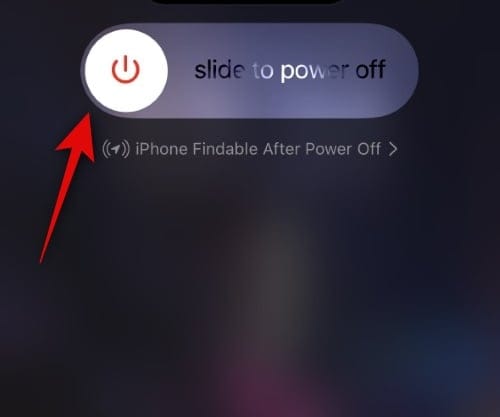
If Personal Voice has been generated on your iPhone but is not showing up in compatible apps and Live Speech, then we recommend you first simply restart your iPhone. A restart is known to fix most issues with Personal Voice, including if it is stuck at 100% completion on your iPhone. Let’s first try a normal restart. Head to Settings > General > Shut Down > Slide to power off. Once your iPhone has turned off, wait for a minute or two and then press and hold the Sleep/Wake button on your iPhone to turn it back on. You can then check in Live Speech or Settings to see if Personal Voice is visible on your iPhone.
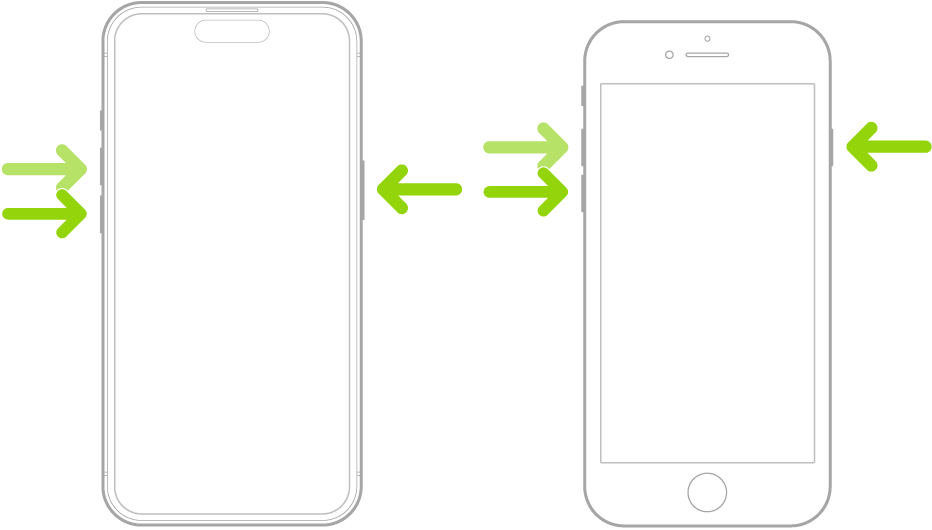
Try Force Restart if a normal restart doesn’t help!
If a restart doesn’t make Personal Voice appear on your iPhone, then we now recommend you force restart your iPhone. A force restart is a more robust method that clears the cache and restarts all background services. This will help fix Personal Voice on your iPhone. To force restart your iPhone, press and release the Volume Up and then the Volume Down button. Once done, press and hold the Sleep/Wake button on your iPhone till you see the Apple logo on your screen. Once the Apple logo appears, let go of the Sleep/Wake button. Let your iPhone now restart normally. Once restarted, Personal Voice should be visible on your iPhone if you were facing issues with cache, leftover files, or background services.
Related: iOS 17 Wi-Fi Icon Not Showing Issue: 15 Fixes Explained
Method 2: Turn off Live Speech
If you had turned off Live Speech before creating your Personal Voice, then unfortunately, you will face known bugs that will cause your Personal Voice to disappear from your iPhone. This is a known bug that has been plaguing many users since the early days of iOS 17 beta. Unfortunately, the only way to fix this issue is by disabling Live Speech first, deleting your Personal Voice if it is visible, and then generating a new voice from scratch again. To do so, first head to Settings > Accessibility > Live Speech > Turn off the toggle for Live Speech.
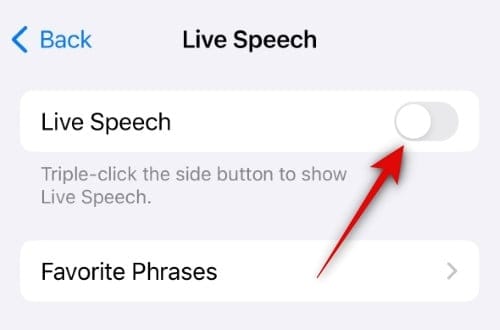
Once Live Speech has been turned off, head to Settings > Accessibility > Personal Voice > Tap on your Personal Voice > Enter a passcode or use Face ID > Delete… > Delete Voice and Recordings.

Your Personal Voice will now be deleted from your iPhone. We now recommend you restart your device before generating a new voice again. Once you have restarted your iPhone, create a new Personal Voice from scratch without enabling Live Speech first. Once you do so and your Personal Voice is generated, you can then enable Live Speech. Personal Voice should then be available and usable for you on your iPhone.
Related: 14 Ways to iOS 17 StandBy Not Working [Updated]
Method 3: Ensure you have a compatible iPhone
While it might seem on the surface that all iPhones running iOS 17 should support Personal Voice, that is simply not the case. Personal Voice is an advanced feature that uses local processing to ensure all your recordings and voice data remain safe and only on your iPhone. Unfortunately, this, in turn, requires your iPhone to be quite capable in terms of processing power. Thus, not all iPhones support Personal Voice. Only iPhones with A14 Bionic or higher will be able to use Personal Voice, which means only the following iPhone series supports Personal Voice as a feature. So, unfortunately, if you own an older device, then the only way to get Personal Voice would be to upgrade to a supported iPhone.
- iPhone 12 series
- iPhone 12 Pro series
- iPhone 13 series
- iPhone 13 Pro series
- iPhone 14 series
- iPhone 14 Pro series
- iPhone 15 series
- iPhone 15 Pro series
Method 4: Ensure your iPhone has enough storage space
While Personal Voice is quite easy to create, it requires some storage space on your iPhone. If you’re thin on storage space on your iPhone, then the process can stop in between, preventing the Personal Voice from being generated on your iPhone. Check if that’s the case — go to Settings > General > iPhone Storage.
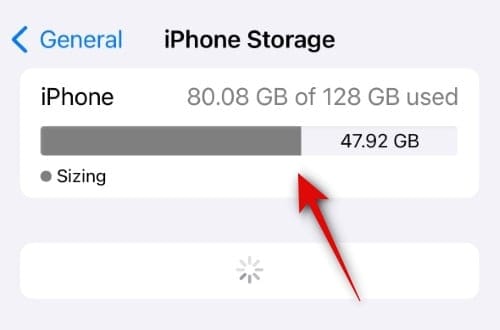
If you see only a handful of GBs spare here, then clear some space on your iPhone first. When let’s say more than 5-10GB is available, try to generate your personal voice again now.
Related: iOS 17 Text Tones Not Working? Quick Fix Explained!
Method 5: Delete your original personal voice and try again
Simply restarting the process again also seems to fix issues with Personal Voice for many users. To do so, you will need to delete your previously created Personal Voice, restart your device, and then create a new Personal Voice again. To delete your previously generated Personal Voice, head to Settings > Accessibility > Personal Voice > Select your Personal Voice > Delete… > Delete Voice And Recordings.

Your previous Personal Voice will now be deleted. Once deleted, restart your iPhone. You can perform a normal restart or a force restart, depending on your preferences. Once your iPhone has been restarted, you can head to Settings > Accessibility > Personal Voice > Create a Personal Voice and create your personal voice again.
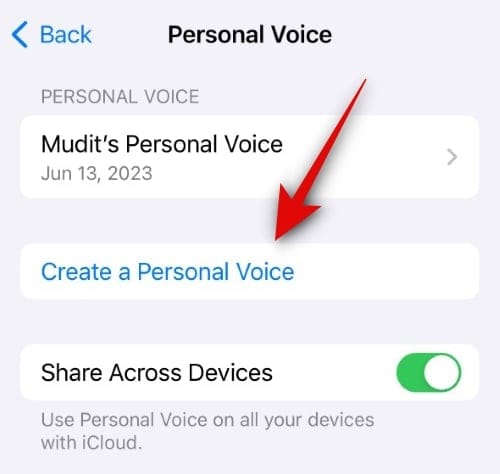
If you were facing temporary bugs or issues with Personal Voice, then this should help you get everything working again on your iPhone.
Method 6: Rename your original Personal Voice and try again
If deleting and setting up your Personal Voice again did not help, then you need to try renaming your previously created Personal Voice and setting up a new one. This seems to be also due to a bug where the new Personal Voice will be treated like the old Personal Voice if it has the same name. In such cases, simply renaming your previous personal voice and creating a new one seems to fix the issue for many users. To rename your previously created Personal Voice, head to Settings > Accessibility > Personal Voice > Select your personal Voice > Name > Rename Personal Voice > Done.
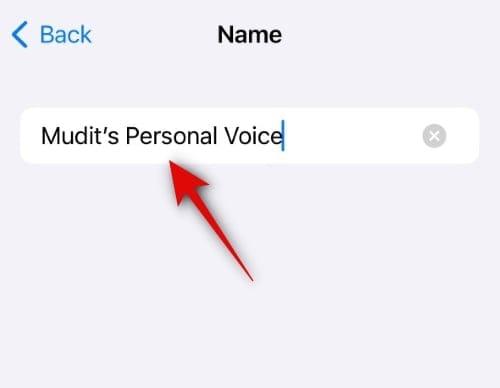
Once you have renamed your Personal Voice, go back twice to the Personal Voice page and tap Create a Personal Voice. You can then follow the on-screen instructions to create your new personal voice. Once it has been created, you should then be able to use it with Live Speech and other Accessibility apps and services.
Related: iOS 17: How to Fix Vibration Change Issue
Method 7: Prepare it well keeping these points in mind!
If your voice is stuck generating, then you should be aware of a couple of things. Firstly, remember that as soon as your screen turns on, your Personal Voice will stop generating in the background. This includes all the times your screen turns on when receiving a notification when getting activated due to Raise to Wake and other such gestures. Additionally, your Personal Voice is processed and generated when your phone is idle, the screen is turned off, plugged into the wall and charging.
It’s not certain, but it’s possible that your phone needs to be charging for the Personal Voice feature to work in the background. If your phone is fully charged, then your Personal Voice probably won’t be processed in the background because it is no longer in a charging state.
Thus, ensure that all these factors are met if you find your Personal Voice stuck while processing. The best way to complete this process at the earliest would be to use your phone throughout the day, ensure it is below 20% charge, and then plug it into the wall for the night while in Airplane mode. This will ensure no activity or notification turns the screen on, and your Personal Voice keeps getting processed in the background.
Method 8: Change your region
If Personal Voice is still missing, unavailable, or not visible on your iPhone, then it is likely that you’re facing a region restriction. You can easily overcome this by changing your region to either the US or Canada. Don’t worry this won’t affect your device, as you will be able to select your date and time, number format, as well as the preferred unit of temperature.
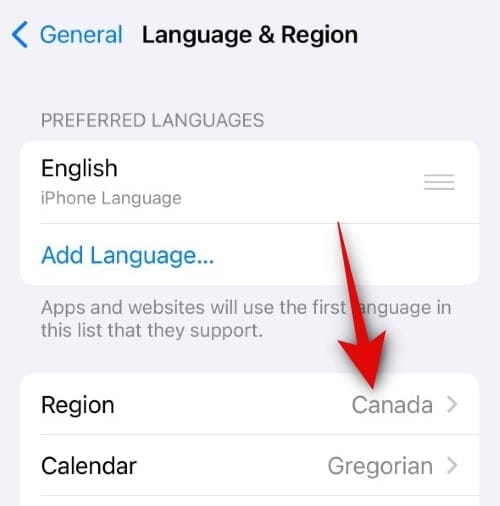
Head to Settings > General > Language & Region > Region to change your region. Select either the US or Canada. Once your region has been changed, we recommend you restart your device just to be safe. Once your phone restarts, you can then head to Settings > Accessibility > Personal Voice. This should help you set up and use Personal Voice on your iPhone without any issues.
Method 9: Use the false second personal voice trick
Here’s another nifty solution for those struggling to create their own Personal Voice. Sometimes, after processing, your Personal Voice may show up in the Settings app but mysteriously vanishes when you try to use it with Live Speech or other third-party accessibility apps. If you encounter this issue, try this simple fix: create a second voice, cancel it halfway, restart your device, and delete the partially created personal voice. That should do the trick!
Once you delete the half-created personal voice, you can access your originally processed voice in Live Speech and other Accessibility apps and services. To create a new second personal voice, head to Settings > Accessibility > Personal Voice > Create a Personal Voice. You can then follow the on-screen instructions to create a new personal voice, but do not complete the entire process. Simply record a few phrases, close the Settings app, and then restart your iPhone.

Once your iPhone restarts, head to Settings > Accessibility > Personal Voice > Select the half-created second personal voice > Delete… > Delete Voice and Recordings.

Once the second voice has been deleted, you can try accessing Live Speech or other third-party accessibility services. You should then be able to select the first Personal Voice you had created on your iPhone.
Method 10: Restart your device a few times
This is the last fix that also seems to work for many users. It seems an inherent bug in the current release of iOS 17 can prevent your Personal Voice from being shown in relevant apps even if it has been processed and everything has been completed on your iPhone. In such cases, all you might actually need is to restart your device multiple times — and pray to god! — until your Personal Voice is visible and usable on your iPhone.
Restarts will help re-register and restart background services, which seem to be the main cause of Personal Voice missing from your iPhones.
When you restart your iPhone a few times, the relevant background services are also restarted, which, after a few tries, seem to fix themselves on their own, which in turn gets Personal Voice working again. So, as a last resort — or, first? — we recommend you restart your iPhone multiple times until Personal Voice appears and is usable on your iPhone.
We hope this post helped you easily fix and use Personal Voice on your iPhone. If you have any issues or have any more questions, feel free to contact us using the comments section below.
RELATED













Discussion